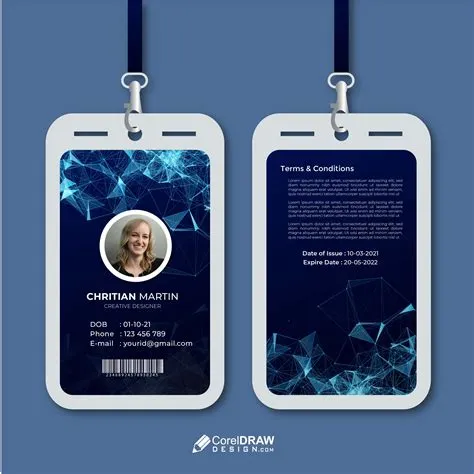Hey there, business owners and design enthusiasts! Ever stopped to think about your company ID cards? They’re more than just a piece of plastic; they’re a walking, talking advertisement for your brand, a symbol of belonging for your employees, and a crucial element of security. But in a world buzzing with innovation, are your ID cards keeping up? Let’s dive into the exciting new trends shaping the future of business ID card design.
Forget the boring, generic ID cards of yesteryear. Today, ID cards are evolving into sophisticated pieces of technology and branding. We’re talking sleek, modern designs that reflect your company’s personality and values. Think of it like this: your ID card is the first impression many people will have of your company. Do you want that impression to be…well, blah? I didn’t think so.
High-Tech Meets High-Style: Integrating Technology
One of the most significant trends is the integration of technology into ID card design. We’re not just talking about adding a barcode; we’re talking about smart cards packed with features. Imagine ID cards with embedded microchips for access control, contactless payment capabilities, or even biometric authentication. These technology-integrated ID cards aren’t just pretty; they’re functional and secure.
Consider the convenience for employees. Access to secure areas becomes seamless. Time-consuming check-in processes are streamlined. The potential for increased efficiency is enormous. And from a security standpoint, biometric authentication offers unparalleled protection against fraud and unauthorized access. This level of sophistication speaks volumes about your commitment to both your employees and your business security. It’s a win-win.
Eco-Conscious Credentials: Sustainability Takes Center Stage
In today’s environmentally conscious world, sustainability is no longer a luxury; it’s a necessity. This extends to ID card production as well. More and more companies are opting for eco-friendly ID card materials, like recycled plastic or sustainably sourced materials. This move not only reduces your environmental footprint but also aligns your business with growing consumer demands for ethical and responsible practices.
But eco-friendly doesn’t mean compromising on style! Many sustainable materials are just as durable and aesthetically pleasing as their traditional counterparts. In fact, many companies are finding that incorporating sustainable practices into their ID card production actually enhances their brand image. It’s a powerful way to show your commitment to a greener future, boosting both your image and your bottom line. Learn more about materials and sustainability in ID card design.
Industry-Specific Designs: Tailoring the Look to Your Business
Your ID card shouldn’t look like everyone else’s. One of the most exciting trends is the rise of industry-specific ID card designs. Think about it: a healthcare worker’s ID card should look different from a tech company’s. This level of customization allows your company to express its unique identity and reinforce its brand messaging.
This customization extends beyond just aesthetics. Consider the functionality. A construction worker’s ID might need to be more durable and waterproof, while a software engineer’s card might emphasize their access credentials. This approach demonstrates a thoughtful understanding of the unique needs of your industry, reinforcing both professionalism and efficiency. Exploring design trends in industry-specific ID cards can provide invaluable insights for crafting a truly effective design.
Personalization: Making Each ID Unique
Beyond industry-specific designs, personalization is key. While maintaining brand consistency, customization and personalization in ID card design allow for unique touches. Think about adding employee photos, names, and even personalized background designs. This small gesture significantly increases employee engagement and boosts morale. It’s a subtle way to make your employees feel valued and appreciated.
Furthermore, think about the impact on security. A personalized ID card is harder to forge or misuse. It adds another layer of protection, further strengthening your overall security protocols. It shows that you value both your employees and the security of your business.
The Power of Branding: Reflecting Your Company’s Identity
Your ID card is a miniature billboard for your brand. It’s a constant, visible reminder of your company’s values and mission. This is why incorporating corporate branding with ID cards is crucial. Consistent use of your logo, color palette, and typography reinforces your brand identity and creates a sense of unity among your employees.
Imagine the impact of a consistently branded ID card. Every time an employee interacts with a client or partner, they are subtly reinforcing your brand message. It’s a powerful, yet often overlooked, branding opportunity. It’s a silent testament to your professionalism and brand consistency.
Beyond the Physical Card: Embracing Digital ID Solutions
The future of ID cards is increasingly digital. Digital and virtual ID cards offer a range of benefits, from enhanced security to reduced costs. They are easily updated, eliminating the need for costly reprints. Furthermore, they can be easily integrated with other systems, streamlining access control and other processes.
Digital ID cards are also environmentally friendly, reducing the need for physical printing and distribution. They present a forward-thinking approach to identification, aligning with the increasing trend towards digitalization across various aspects of business operation. It’s a shift that’s both innovative and sustainable.
Security and Access Control: Prioritizing Protection
Regardless of the design trends, security remains paramount. Your ID cards should be designed with robust security features to prevent fraud and unauthorized access. This is where security and access control measures play a vital role. This might involve incorporating holograms, watermarks, or other anti-counterfeiting techniques.
Incorporating advanced security features not only protects your company’s assets but also assures your employees of a safe and secure working environment. A secure ID card system is an investment in the peace of mind of your entire workforce.
The design of your business ID cards is not a minor detail; it’s a strategic decision with far-reaching implications. From boosting employee morale to enhancing brand recognition and reinforcing security, your ID cards play a significant role in the overall success of your business. By embracing innovative design trends, you can create ID cards that are not only functional and secure but also reflect your company’s unique identity and commitment to excellence. Ready to elevate your company’s image and efficiency? Start exploring the possibilities today! Check out more resources on our blog: Amazing Biz ID Blog and explore modern ID card design ideas for inspiration.
Conclusion
The world of business ID card design is constantly evolving, offering businesses endless opportunities to create functional, secure, and stylish identification solutions. By embracing innovative technology, sustainable practices, and personalized designs, companies can transform their ID cards from mere necessities into powerful branding tools and expressions of corporate identity. It’s time to move beyond the basic and embrace the future of ID card design – a future that’s both sleek and secure.
FAQs
- What are the most common security features incorporated into modern ID cards? Modern ID cards often incorporate holograms, UV printing, watermarks, embedded microchips, and even biometric authentication for enhanced security against counterfeiting and unauthorized access.
- How can I ensure my ID card design aligns with my company’s brand identity? Close collaboration with a designer is key. Provide them with your brand guidelines, including logo, color palette, typography, and overall brand messaging, to ensure consistency across all materials, including your ID cards.
- What are some sustainable materials used in eco-friendly ID card production? Recycled plastic, sustainably sourced bamboo, and plant-based polymers are all becoming increasingly popular as eco-conscious alternatives to traditional PVC.
- How can I integrate technology into my ID cards without compromising on design? Modern technology allows for seamless integration. Microchips and other tech features can often be subtly incorporated without detracting from the overall aesthetics. Working with experienced designers ensures a harmonious blend of form and function.
- What’s the difference between a digital and a physical ID card? A physical ID card is a traditional plastic card, while a digital ID card exists solely as a digital file, often accessed through an app or other digital system. Digital IDs offer flexibility and convenience, while physical cards may be preferable for certain security or access control needs.

